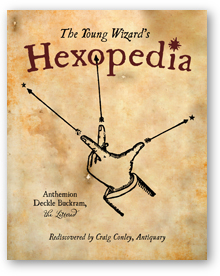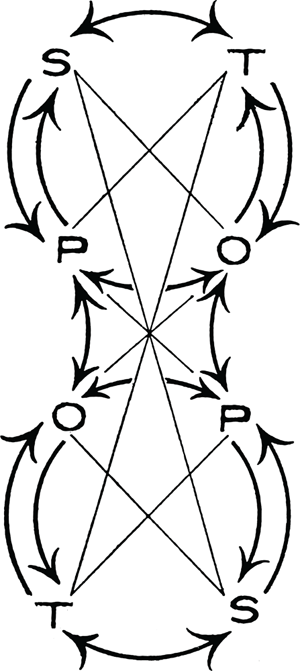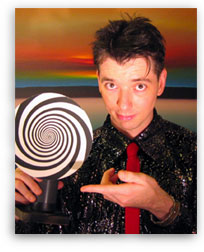|

|
The Young Wizard’s Hexopedia The Hexopedia is a one-of-a-kind story of magic words — what they’re made of, where they came from, where they can take you, and how they interact with the world and with each other. It is a whimsical training manual on speaking, writing, and listening magically. It is a treasure chest of hands-on techniques to access the full wisdom and power for beginning things, attracting things, protecting things, and bestowing things. It reveals how to assemble, paint, and manipulate words, even invisible words. It teaches how to become fluent in the language, or rather languages, of spellcraft, and how to interact on a magical level with the elements, the animals, and the trees. It is meant to enlighten its young readers and inspire them to create pure wonder and awe whenever they speak. Sources range from the hierophants of ancient Egypt; to the high priests, medicine men, sorcerers, and alchemists of the Middle Ages; to the necromancers and wizards of legend and fairy tale; to the workers of wonders and miracles throughout history. The Hexopedia showcases those powerful words and spells that give shape and form to ungraspable feats. The Hexopedia was inspired by the fact that the shop windows of Universal Studios’ Wizarding World of Harry Potter (Los Angeles and Orlando) display genuine-looking tomes of magic but don’t offer them for sale. The Hexopedia looks, feels, and reads like an authentic artifact of wizardry, appealing to young fans of Harry Potter, Oz, Lord of the Rings, and other sword-and-sorcery books, films, and video games. Magic words are naturally as old as conjuring itself, echoes of the rhythm and vibration of creative power. A great many of these words have stood the test of time, passed on from master to apprentice, generation through generation. These ancient, musical, poetic incantations have a profound — but not necessarily unfathomable — mystique. For example, there is profound meaning in the clichéd image of a magician pulling a rabbit out of an empty hat with the word abracadabra. The magician is speaking an ancient Hebrew phrase that means “I will create with words.” He is making something out of nothing, echoing that famous line from Genesis: “Let there be light, and there was light,” only in this case the light is a white rabbit and perhaps a flash of fire. The magic word, whether it be abracadabra or another of the magician’s choosing, resonates with us because there is an instinctive understanding that words are powerful, creative forces. Unlike with so many magic books on the market, parents need not fear any nefarious intent or ideological subtext; The Hexopedia promotes a deliberately positive, universal message about empowering one’s communication skills for beneficial results. This is not an indoctrination into any system of belief or religious practice; rather, the book encourages readers’ imaginations as it slyly teaches ways to choose words carefully. The book offers text and diagrams that seem mysterious and occult yet are constructive and purposively devoid of religious overtones of any kind. The Hexopedia is expressly designed to foster treasured youthful experiences, inspiring a love of literacy and learning as it promotes intellectual growth through enchantment and entertainment. CONTENTS 
PRAISE FOR THE HEXOPEDIA “Immensely enjoyable. An ideal grimoire ... an excellent reference.” —Oberon Zell-Ravenheart, author of Grimoire for the Apprentice Wizard (New Page Books, 2004) “Reader! All learned wizards know there is magic in words. This volume is your guide to unlocking them, even if you are not so fortunate as to be enrolled in a school for young magicians. Read. Breathe. Be spellbound. And then set your magic loose with this invaluable volume by the Lettered Anthemion Deckle Buckram and his capable antiquary, Craig Conley.” —Martha Brockenbrough, author of Devine Intervention (Levine, 2012) “Craig Conley has channelled a new masterpiece. Hexopedia is an utterly enchanting and enthralling book. Just read the very first words, and you are in wonderland. Offering a uniquely participatory reading experience, Hexopedia awakens us to a fundamental—albeit often neglected—secret of magic: that words have the power to affect reality in very concrete ways. Get lost in the Hexopedia; you’ll find your new Self.” —Ferdinando Buscema, co-author of L’Arte di Stupire (Sperling & Kupfer, 2014) “Hexopedia is a wonderful book! It is highly whimsical and fun, yet full of practical examples and wise insights about the power of words to set us free from old patterns of thinking and behaving. Hexopedia promotes creative thinking by encouraging a playful approach to language. Through learned insights about the magic of words (and magical words), and delightful, often illuminating illustrations, it encourages readers to affirm themselves and explore new potentials. If Hogwarts were real, this book would be mandatory reading for all its students.” —Lawrence Hass, Ph.D., Professor of Humanities at Austin College, Associate Dean of Jeff McBride’s Magic & Mystery School, and author of Transformations: Creating Magic Out of Tricks (Theory and Art of Magic Press, 2007) “The Hexopedia is charming. So beware. It bewitches, captivates, enchants, lures and seduces. It is wise, but also delightfully foolish. It is quite serious and yet entertainingly silly. What fun is this book’s toying with images and letters! The results are both beautiful and provocative. The book is like the author, so one-of-kind that fair description of the content is impossible. Therefore, welcome the hex. If you have the nerve to allow it, you will discover an imagination nonpareil, his and your own. Take a chance.” —Dr. Robert E. Neale, author of Magic and Meaning (Hermetic Press, 1995) “It takes bravery to make magic happen with words. It’s courageous and exciting and fun to even try to learn magic. There is something deeply subversive about learning. It’s a taking apart, an inquiry into the dark halls, the forgotten corners, the undersides of things. The security guard is somewhere else, and the students and the teachers conspire. They are alchemists. Things are not how they first appear to be. Behind each thing is something else. Everything can be reassembled in another way. There’s a code, a ghost, a magic trick to the world. Hence, the Hexopedia.” —Gary Barwin, author of Seeing Stars (Fitzhenry and Whiteside, 2001) “Craig Conley’s Hexopedia not only surprised and delighted me, it changed my opinion about what young adult books could be. What a treat!” —Gordon Meyer, author of Smart Home Hacks (O’Reilly, 2004) “We might call a bookish person a ‘walking encyclopedia,’ but what do we call a printed work with its own wits? The Hexopedia reads your mind as you cast your eye over its pages, but what’s more, it proves beyond a doubting shadow that you and you alone are the reader it has been waiting for.” —William Keckler, author of Sanskrit of the Body (Penguin, 2003) “Is Conley’s Hexopedia considered the ‘new magic?’ or is ‘Hex-O’ the old magic renewing itself? Perhaps ‘Hex-O’ is the phoenix of this generation?” —Jeff McBride, author of The Show Doctor (Theory of Art & Magic Press, 2014) “Hexopedia promotes a deliberately positive, universal message about empowering one’s communication skills for beneficial results. The Hexopedia is expressly designed to foster treasured youthful experiences, inspiring a love of literacy and learning as it promotes intellectual growth through enchantment and entertainment. Language gives genuine power and wonder to magic. The Hexopedia is a master course in spellbinding words that can make wizards of us all.” —Abigail Spinner McBride, author of Mystery School (The Miracle Factory, 2003) “The most important lesson that I’ve learned [through magic] is that you are the magician in your own life, and you either play it or you don’t. The Hexopedia is a welcome invitation to play.” —Eugene Burger, author of Mastering the Art of Magic (Kaufman and Co., 2000) “A wizard is defined by words spoken and secrets kept. The Hexopedia is trove of magical words and secrets.” —Kenton Knepper, author of Wonder Words (Wonder Wizards, 2004) “Craig Conley is a word-goldsmith. Or a word-alchemist. He mixes fun, pun and profundity in an imaginative way, thereby opening your mind like nasal spray opens up your sinuses. In this book he guides young wizards through the initial chaos of magic with amazing clarity and coherency. You won’t read this book cover to cover. You will dive in wherever you like and be sure you will learn a little something that you won’t forget for the rest of your life, simply because you will put it to use. Whatever that use may be. Lie down in your hammock and gently sway between the magic of imagination and reality while you utter magic words to prevent yourself from falling out when your world is rocked by this book.” —George Parker, author of The Big Book of Creativity (2004) “Craig Conley’s Hexopedia is a literally marvelous grimoire. It should be put into the hands of bright youngsters and the curious of all ages. A truly multicultural miscellany of lore and lingo, jeweled with the legends of the globe, The Hexopedia uncovers the hidden meanings of common words and counsels an appreciation of life’s endless depth. For the magic-averse, it can be appreciated as a novel without a plot: a map of a world in which churches and dragons, memory palaces and magic mirrors, are as mundane as they are mystical — where, in other words, nothing is mundane. And the ‘reasonable’ dilettante-occultist litterateur can read it with clean-conscience pleasure for its allusive and anagrammatic wit, its pleasant recollections of Borges, Calvino, and Emerson. This book will become famous in an emerald city for its demonstration that language itself is magic.” —John Pistelli, author of The Ecstasy of Michaela (Valhalla Press, 2012) |
|||||||||||||||||||||||||||||||||||||||||||||
 |
About the AuthorCraig Conley is a magic enthusiast and scholar. Recognized by Encarta as “America’s most creative and diligent scholar of letters, words and punctuation,” his intensive and eccentric research has led him to compile a true masterwork entitled Magic Words: A Dictionary. He has also authored One-Letter Words: A Dictionary, among other strange and unusual lexicons, and is a regular columnist for Pentacle magazine. Conley’s ideas are often decades ahead of their time. He invented the concept of the “virtual pet” in 1980, fifteen years before the debut of the popular “Tamagotchi” in Japan. His virtual pet, actually a rare flower, still thrives and has reached an incomprehensible size. Featured Works: Published Works |
|||||||||||||||||||||||||||||||||||||||||||||
|
|
Online Resources |
|||||||||||||||||||||||||||||||||||||||||||||
A free daily symbolic outlook
|
||||||||||||||||||||||||||||||||||||||||||||||